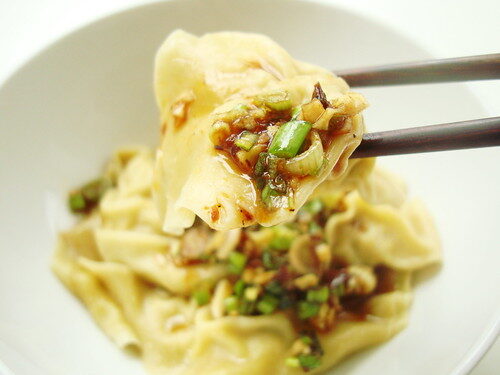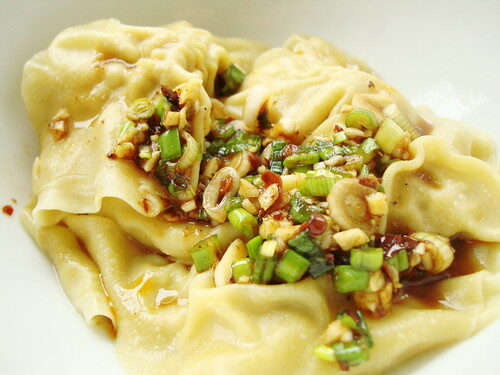
Being Cantonese and with a preference for more delicate, subtle flavours, my repertoire of Sichuan dishes is miniscule (dan dan mian, Sichuan hot pot), although I do like to eat in Sichuan restaurants once in a while (Ba Shan, Chilli Cool, Bar Shu, Snazz Sichuan). During my stint in Beijing though, I had no alternative but to develop a taste for spicier food as there weren’t that many good, or even decent, restaurants thirteen years ago, and Sichuan restaurants did particularly well back then.
I like these Sichuan wontons, known locally as chao shou, which I had most recently at Ba Shan. Chao shou are ‘xiao chi’, literally small eats, and are a popular snack food. The good thing about making them yourself is that you have total control over the level of spiciness, although traditionally the accompanying sauce is supposed to be hot and spicy. And if you don’t like them mala, literally ‘numbing and spicy’, then don’t garnish with Sichuan peppercorns. I had intended to use these, but must have subconsciously forgotten it until I was halfway through my wontons! Personally, they weren’t missed.
I used Ken Hom’s recipe from his Taste of China book, written in 1989 after a long journey around the country, during which he collected many interesting recipes. I’m not so sure about the authenticity of some of the recipes in his other books, but I do recommend this book, for both the recipes as well as anecdotes and useful information gleaned from eating in people’s homes and visiting food markets (at a time when most restaurants were state-owned and terrible).

Ingredients: (serves 4 as part of a meal, or 2 as a single dish)
- 1 packet wonton wrappers, about 30 to 35 (the ones I bought from See Woo supermarket in London’s Chinatown were excellent, though I’m trying various brands to see which texture I prefer the most. NB these are square and not to be confused with spring roll or jiaozi wrappers!)
- 1 tbsp Sichuan peppercorns, dry roasted and ground (as garnish)
Filling:
- 350g / 12oz minced pork (I hand mince my pork, which takes a bit longer, but you can buy it minced too)
- 1 egg, beaten
- 1 tbsp sesame oil
- 2 tsp salt
- ½ tsp freshly ground black pepper
Sauce:
- 1 tbsp finely chopped garlic
- 4 tbsp finely chopped spring onions
- 3 tbsp dark soy sauce
- 1 tbsp sugar
- 1 tbsp chilli oil (you can adjust to your own preference)
- 2 tsp Chinese black vinegar
- ¼ freshly ground black pepper

What to do next:
Combine pork, egg, sesame oil, salt & pepper in a large bowl and mix well. Using a teaspoon, add a small amount of filling in the centre of each wonton skin.
There are different ways of sealing and wrapping a wonton, but being a novice, I chose the easiest way and simply folded the wrapper into a triangular shape. You’ll need to use a little bit of water to dampen the edges and press them together.
Also remember to squeeze as much air as possible out of the wonton during the sealing process (otherwise you’ll see what happens during the boiling process!). And don’t overfill the wrapper. Although the wrapper is quite stretchy and malleable, it’s still delicate and you don’t want it to tear.
There were various sizes of wonton wrappers, and I chose the smallest for this dish, but there was still more than enough wrapper to create the lovely floaty folds.
Combine the garlic, spring onions, soy sauce, sugar, chilli oil, vinegar and pepper and mix well. You can add this to a large serving bowl or divide into smaller individual ones.
Bring a large pot of water to the boil. Hom doesn’t mention this, but it’s important to add a tablespoon or two of vegetable or groundnut oil to the water, as this prevents the wontons from sticking together. Add the wontons and simmer for 4 minutes. I stirred the water a couple of times just to make sure the wontons weren’t sticking together.
Remove with a slotted spoon and add to the serving bowls. Mix gently with the sauce, garnish with the Sichuan peppercorns (which should be dry roasted in a pan or wok to release the flavours before grinding with a pestle and mortar), and serve at once. Be warned, the raw garlic will give you super garlicky breath for at least 24 hours! But these are certainly worth it…
More Chinese recipes on Lay The Table here. The next recipe will be for Cantonese wonton noodles, right up my street!
@ Lay The Table